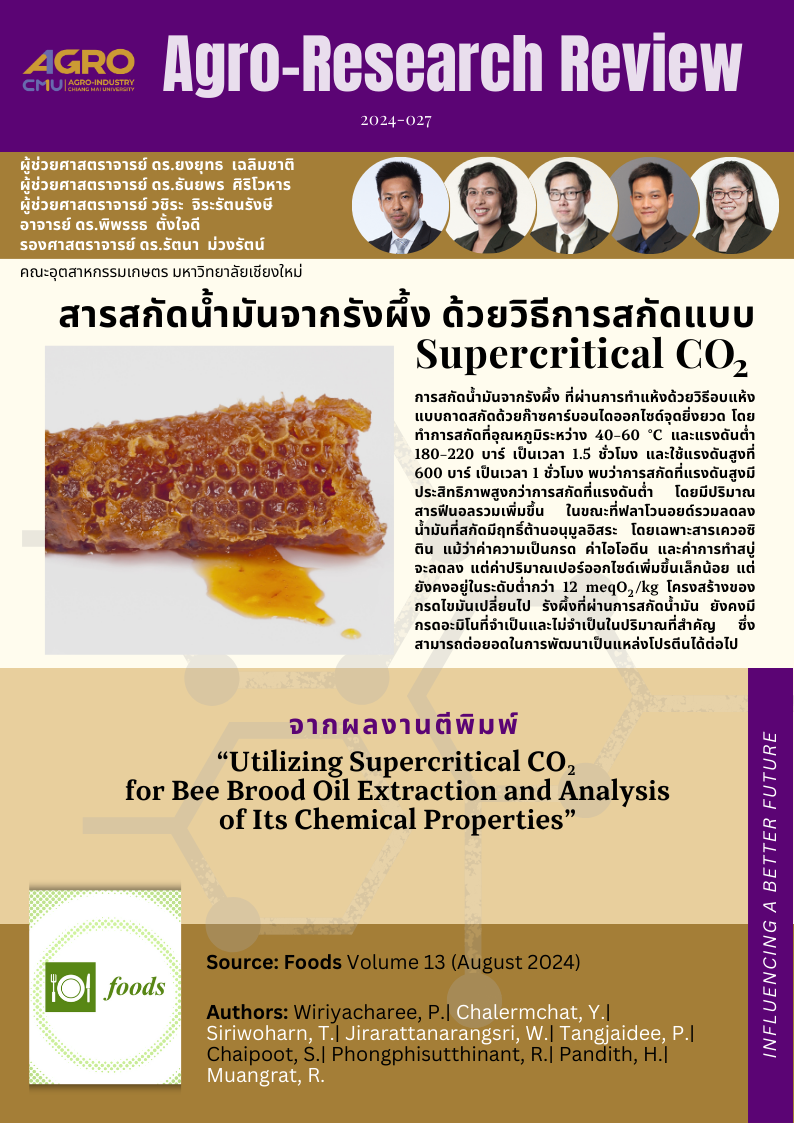
แนะนำงานวิจัย 2024-027 สารสกัดน้ำมันจากรังผึ้ง ด้วยวิธีการสกัดแบบ Supercritical CO2
การสกัดน้ำมันจากรังผึ้งที่ผ่านการทำแห้งด้วยวิธีอบแห้งแบบถาด สกัดด้วยก๊าซคาร์บอนไดออกไซด์จุดยิ่งยวด โดยทำการสกัดที่อุณหภูมิระหว่าง 40–60 °C และแรงดันต่ำ 180–220 บาร์ เป็นเวลา 1.5 ชั่วโมง และใช้แรงดันสูงที่ 600 บาร์ เป็นเวลา 1 ชั่วโมง พบว่าการสกัดที่แรงดันสูงมีประสิทธิภาพสูงกว่าการสกัดที่แรงดันต่ำ โดยมีปริมาณสารฟีนอลรวมเพิ่มขึ้น ในขณะที่ฟลาโวนอยด์รวมลดลง น้ำมันที่สกัดมีฤทธิ์ต้านอนุมูลอิสระ โดยเฉพาะสารเควอซิติน แม้ว่าค่าความเป็นกรด ค่าไอโอดีน และค่าการทำสบู่จะลดลง แต่ค่าปริมาณเปอร์ออกไซด์เพิ่มขึ้นเล็กน้อย แต่ยังคงอยู่ในระดับต่ำกว่า 12 meqO2/kg โครงสร้างของกรดไขมันเปลี่ยนไป รังผึ้งที่ผ่านการสกัดน้ำมันยังคงมีกรดอะมิโนที่จำเป็นและไม่จำเป็นในปริมาณที่สำคัญ ซึ่งสามารถต่อยอดในการพัฒนาเป็นแหล่งโปรตีนได้ต่อไ
Oil extraction from dried honeycombs, which were dried using a tray drying method, was performed using supercritical carbon dioxide (CO2) extraction at a temperature range of 40–60°C and low pressure of 180–220 bar for 1.5 hours, followed by high pressure of 600 bar for 1 hour. It was found that extraction at high pressure was more efficient than at low pressure, resulting in an increase in total phenolic content, while total flavonoid content decreased. The extracted oil exhibited antioxidant properties, particularly due to quercetin. Although the acid value, iodine value, and saponification value decreased, the peroxide value slightly increased but remained below 12 meqO2/kg. The fatty acid composition of the oil was altered. The residual honeycomb after oil extraction still contained significant amounts of both essential and non-essential amino acids, suggesting potential for further development as a protein source.
Topic: Utilizing Supercritical CO2 for Bee Brood Oil Extraction and Analysis of Its Chemical Properties
Authors: Wiriyacharee, P.| Chalermchat, Y.| Siriwoharn, T.| Jirarattanarangsri, W.| Tangjaidee, P.| Chaipoot, S.| Phongphisutthinant, R.| Pandith, H.| Muangrat, R.
Abstract:
To obtain oil from bee brood, which was dried using a tray drying method, this study used the supercritical CO2 extraction method. Extraction occurred at temperatures between 40–60 °C and low pressures of 180–220 bar for 1.5 h, with a high pressure of 600 bar for 1 h. The study investigated both the yield and chemical properties of the extracted bee brood oils. Supercritical CO2 extraction of tray-dried bee brood at 600 bar pressure demonstrated higher oil extraction efficiency compared to lower pressures (180–220 bar). At temperatures of 40–60 °C, total phenolic compounds increased while total flavonoids decreased. The extracted oil exhibited antioxidant activity, primarily due to quercetin. Despite decreased acid, iodine, and saponification values, peroxide value slightly increased but remained below 12 meqO2/kg of oil. The make-up of the fatty acids changed. At 600 bar, palmitic and oleic acids were the most common, while myristic, linoleic, and docosadienoic acids decreased. At 600 bar, eicosadienoic acid was absent. The defatted bee brood retained significant essential and non-essential amino acids, indicating its potential for further development as a protein source.
Keywords: supercritical CO2 extraction; tray-dried bee brood; quercetin; total flavonoids; fatty acids
View at publisher: https://www.mdpi.com/2304-8158/13/16/2486
#อกมช. #agrocmu #CMU





